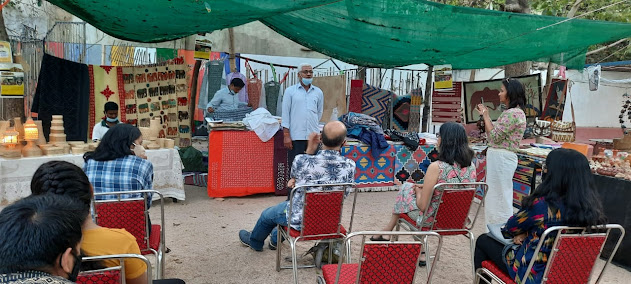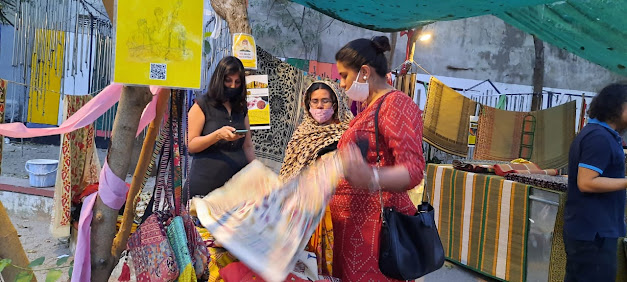Folk Safar Jaipur- The start of a new journey……
Author: Devdan Mookerjee
"Safar ka hi tha main, safar ka
raha…."go
the lyrics of a song from a popular Shah Rukh Khan film.
Without me trying to glorify myself, such has been my journey since I left school. 10 years into the job at banglanatak dot com and the organization faces the toughest challenge with the pandemic. And then comes the latest innovation, Folk Safar as a festival and as a venue, and certainly creates opportunities for the rural folk & handicraft artists.
After a successful Folk Safar festival at Kolkata, the Captain gives the new ball to me to try and swing it on a relatively new pitch at Jaipur. The space is Krishna Niwas in a posh upmarket locality of Jaipur owned by the Arya Niwas Hospitality group. Their CEO, Tarun Bansal, is suave, soft spoken, well versed with history and culture, humble, down to earth, with all the qualities of a true gentleman. So the pressure on me to perform builds up a wee bit more.
Initially
I am joined by the Vice Captain and I would have young Savan from the
Manganiyar community to assist me for the 2 months. 'Manganiyar' represents
melodious music to me, but Savan is just the opposite - short, pleasant and no
music :-). Expect the unexpected becomes the new mantra during the revival post
pandemic!
The
craft exhibition begins. We sit out the entire day and the first visitor comes
only in the evening time. And then a few more. This is how the next few days
go. The sale figures perturb me a bit but we are pacified by the Captain with
his & my vice captain's little experience in a similar space at Goa. One
word- unpredictable!
The
first weekend performances with the Manganiyars saw a crowd of around 50 odd
people. The handicrafts too sold well. A few hiccups here and there. The
volunteers to fix the sound arrive late so I am working with an electrician to
get the system going. And the main wire turns out to be faulty! Delay! I can
see one of my bosses waiting to blast in a fit of rage. And then finally I hear
the first sound from the lone speaker. Relief! As terrible as the sound may
have been for the evening, the Manganiyars managed to pull off a clinical
performance ending in people dancing ecstatically. We decide to go for
professional sound equipment or unplugged for the upcoming events.
One of the leading Manganiyar artists decides at late night that he will stay back another day. As much as we would have loved to have him all the time, but I got worried about the logistics plan needs which need to be changed, and thus I pushed the panic button but are again pacified by the Captain saying that things might just completely change the next morning. And that is what exactly happens. Experience definitely counts.
Putting up posters is quite an ordeal especially when the cafes and restaurants were not too welcoming of promoting other events. Our only support is from students who put it up at their hostels. It is quite encouraging to see the youth taking pride in traditional culture. One of the weeks, I cannot even find a car to hand out the posters because of the marriage season (which is a big thing here), so I fix it for the next day. That of course was no excuse for a fiercely competitive management trying to establish a new model after the pandemic disaster faced by the rural traditional artists communities. There was no margin for delay and quite naturally, I had to face the music. But I realized that the best way to go about this is to take it with a pinch of salt, learn and move on.
In the midst of it all, I have also managed to introduce myself to the world of social media for the sake of promotions. It seems like a maze of information to me in which I get completely lost every time I log in. I am extremely grateful to some of my dear colleagues for being able to make sense of it amidst all the cacophony. We have got little support from the media so far, but would need more of it in the days to come, captain says 'patience'.
One
of the partnerships that has worked is with the Jaipur Creative Commune. They
conducted storytelling sessions as well as a pottery workshop with the
handicraft artists which resulted in reaching out to the interested set of
people. Jaipur Virasat Foundation also has their office in the same premises
and they have been gracious too in promoting through their social media
handles. Oriane, a French lady who is now more of a desi bahu, runs a café within the premises and she too does her bit
to promote. So it is a consolidated effort in trying to reach out to people.
And this is simply because of Tarun's leadership.
The
performances in the next few weeks were by the Mirs from Rajasthan and the Baul
Fakirs from Bengal. A point that needs to be noted is that the artists from
Rajasthan initially were not comfortable in 'Baithaki' format, whereas Baul
Fakirs of Bengal were completely at ease because of their akhra format.
Another
feather that has been added to my cap is that of a compere. The only talking
that I have done in the past is the trash talk with my friends at parties so to
talk sense in front of people was a challenge. But with a bit of preparation
and support from informative short films, I have managed to pull it off
decently well, so I am told and that does feel good.
I
am scheduled to leave on 8th April, my junior colleague Rai will take over from
me and will run the first phase scheduled till 25 April. I will be off to North
Assam tea gardens to join a big project, I am sure Rai will do a great job and
I will keep remembering my unique experience in Jaipur including a 3 days 'quiet'
stay with 'vegetarian food' at Arya
Niwas during Holi!
Happy
Holi!
To know more: https://youtu.be/QFwXQcB1HQo










Comments
Post a Comment